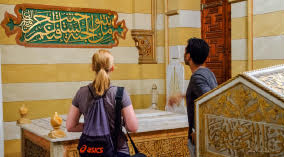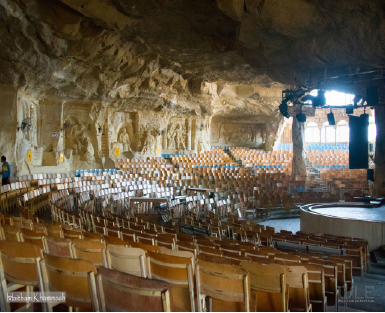MEO reporter, Amira Elhamy had the pleasure to interview Asmaa Khattab Founder of Walk like an Egyptian SME, which its main mission is to uncover Egypt’s historical hidden gems and highlight its mysterious heritage while enjoying walking in Egypt’s landmarks !
How did you start your own business “Walk like an Egyptian SME”?
Well, I graduated from the Faculty of Tourism and Hotel Management, and during my studies I discovered a special passion for tour guiding. Following my graduation, I worked as an employee in a company for touristic services; while I was working I had many concerns that made me really wonder if tourists who visit Egypt are well served or not!
First of all, as a tour guide, following the program of the company I am working for, I had several concerns rising on the surface! First of all I had a problem eating at the restaurants that were serving the food to the tourists! The company made deals with restaurants that provide poor food quality! Second, the company also made deals with shops and bazars, that would sell souvenirs and papyrus to tourists with really high prices, and the extra commission would be divide between the tour guide and the company! I really felt there was something wrong in how tourists were treated here in Egypt!
Another concern I had, was the fixed touristic programs that the companies offer; always same programs! I felt there wasn’t enough creativity in setting programs that will reveal Egypt hidden gems!.
My idea of Walk Like an Egyptian SME, came from these three main concerns! I wanted to establish a company that will give a chance to tourists to enjoy, Egypt, as Egyptians do! Without being exploited from tourism companies, bazars or restaurants! and it all started in 2011! I did quit my job and decided to establish my own company, with a competitive edge that would give a luxurious touristic services, while setting really creative touristic programs that would give tourists a chance to see Egypt hidden gems, and enjoy their time as we Egyptians do. As this critical time as well, with the instability that Egypt was facing, it was a perfect timing for me to contribute with a good move to revive the tourism sector as a whole.

What is the competitive edge of Walk like an Egyptian?
Well, I would say it is the service presented and the places we pick for our tours, as well as our tour guides; in Egypt we do have many tour guides however, we really miss well educated tour guides, and this is sure something we are really keen about. As well, I avoid organizing tours with large numbers; ideal groups ranges from 10 to 15 tourists only. I always try to set standards for the number of groups attending, as I try to maintain an excellent quality service. As well, it is crucial to me to conduct a survey after the tour, to know from the tour attendees their feedback about the tour.
Does your company serve only tourists?
Well let me tell you that we do have many Egyptians who show interest in our tours; there is actually a stereotype among tour guides that Egyptians are not interested to discover Egypt’s heritage and history; well this is not true; our tours witness considerable turnout from Egyptians as well as well as foreigners.
What is your main mission that you try to implement through Walk like an Egyptian?
“Uncover and share the passion of Egypt’s history and heritage; really our edge is sharing Egypt’s heritage through cozy luxurious travel experience.

Tell us how do you select the touristic sites of your tours and please recommend us some touristic sites in Cairo?
Well I am always keen to select unpopular touristic spots that are not visited by main stream tourism companies! In Cairo, I would really recommend City Of the Dead, which is a series of vast Islamic-era necropolises and cemeteries in Cairo. They extend to the north and to the south of the Cairo Citadel, below the Mokattam Hills and outside the historic city walls, covering an area roughly 4 miles long. They are included in the UNESCO World Heritage Site of “Historic Cairo”.
It was built during the Mamluk era (13th-15th centuries). Throughout their history, the necropolises were home to various types of living inhabitants as well. These included the workers whose professions were tied to the cemeteries like gravediggers, tomb custodians. the Sufis and religious scholars studying in the religious complexes built by sultans and other wealthy patrons, and the regular inhabitants of small urban settlements and villages in the area. The first one who built in this area was Sultan Farag Ibn Barquq.
The historical place embraces Princess Shwikar memorial which has the shape of a bed made of marble! It is unbelievably breath taking. As well, the mosque that was built by Sultan Barquq is beautifully made; it also hosts the memorial of Khedive tawfiq, which is a must see!
Another place I recommend in Cairo is Al-Darb Al-Ahmar historic neighborhood, including Bab-el-Wazir main street, which starts from the Citadel till Bab Zuweila, this remarkable street has the blue mosque! The only blue mosque in Egypt; which has a story behind it that is interesting to know about!
The street also embraces Beit Al Razez, built during the era of Mamluks. There is a crucial important point I need to mention Aga Khan Foundation in Egypt, is working on a big restoration project to revive the heritage of Al- Darb Al Ahmar. I believe that the government is doing a great mission which is reviving the Egyptian history and heritage and preparing the City of Cairo to be a must visit touristic destination!
Hosh al-Basha is another touristic site I recommend to visit, which is a mausoleum of the Royal Family of Muhammad Ali Pasha at road al-Imam Al-Shafi‘i in the Southern Cemetery of Cairo, Egypt. Monastery of Saint Simon, or the massive cave church of Cairo’s Zabbaleen community, is also a must hit destination located in Al Mokattam neighborhood , and let me tell you that there is an important association located there named Association for the Protection of the Environment (APE), which aims to help the traditionally marginalized group living in El zaballenn to find innovate ways to support the environment and aid themselves; it focuses on developing environmentally sound waste management and recycling techniques, which help to build the human capacity of the Zabbaleen communities, to “recycle and re-use”.


